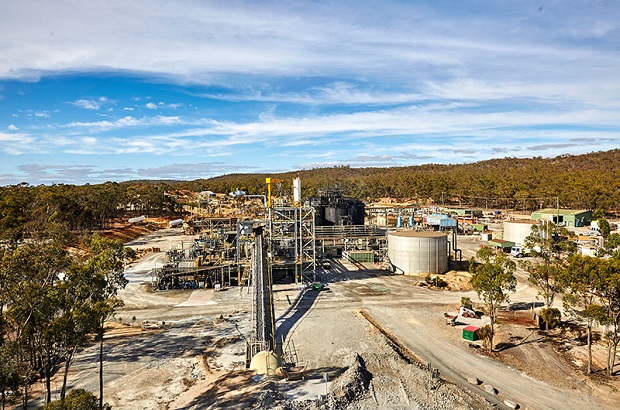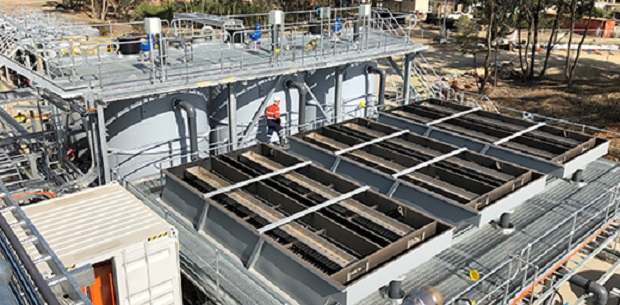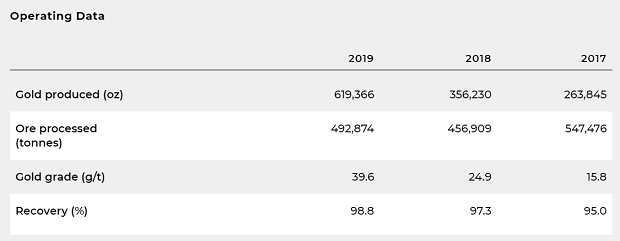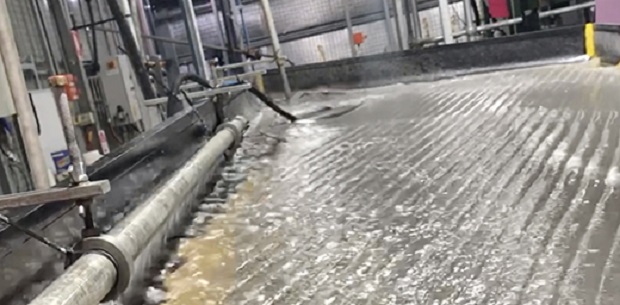FOSTERVILLE MINE IS THE LARGEST GOLD PRODUCER IN THE STATE OF VICTORIA, AUSTRALIA
The Fosterville Mine is a high-grade, low cost underground gold mine, located 20km from the city of Bendigo in the State of Victoria, Australia. The Fosterville Mine features growing gold production at increasingly high grades, as well as extensive in-mine and district scale exploration potential.
Fosterville commenced operation in 2005 and, during its initial years, produced gold from near-surface, low-grade mineralization. A major inflection point was achieved in 2015 with the discovery of the Eagle zone, containing high-grade visible-gold bearing mineralization, which resulted in a significant improvement in the mine's overall Mineral Reserve grade, production profile and unit cost performance. In 2016, exploration work documented similar visible-gold bearing zones at depth in the Harrier zone. Additional exploration progress early in 2017 resulted in new Mineral Reserve and Mineral Resource estimate for the operation being released as at June 30, 2017, which more than doubled underground reserves to 1.03 million ounces (1,790,000 tonnes) and increased the average underground reserve grade estimate by 83% to 17.9 g/t Au. The significant increase in Fosterville Mineral Reserves was supported by down-plunge extensions of the high-grade, visible gold-bearing Lower Phoenix Gold System. In particular, the Swan Zone (previously known as Lower Phoenix Footwall) contributed 532,000 ounces at an average grade of 58.8 g/t Au (281,000 tonnes) to the updated Mineral Reserve estimate.
With continued exploration success over the remainder of 2017, an additional Mineral Reserve and Mineral Resource estimate was released as at December 31, 2017, with Mineral Reserves increasing another 65% from the June 30, 2017 estimate to 1.70 million ounces (2,290,000 tonnes) at an average grade of 23.1 g/t Au, including 1.16 million ounces (588,000 tonnes) of Mineral Reserves in the Swan Zone at an average grade of 61.2 g/t Au. Continued drilling in the Lower Phoenix system during 2018 resulted in another significant increase in the Fosterville Mine Mineral Reserves. Mineral Reserves as at December 31, 2018, increased by a million ounces to 2.7 million ounces (2.7 million tonnes) at an average grade of 31.0 g/t, including a Mineral Reserve in the Swan Zone totalling 2.3 million ounces (1.47 million tonnes) at an average grade of 49.6 g/t.
The mine is located in an area with well-developed infrastructure and is accessible by paved roads. Fosterville’s ore is processed at the Fosterville Mill, a 2,275 tonne per day processing facility.
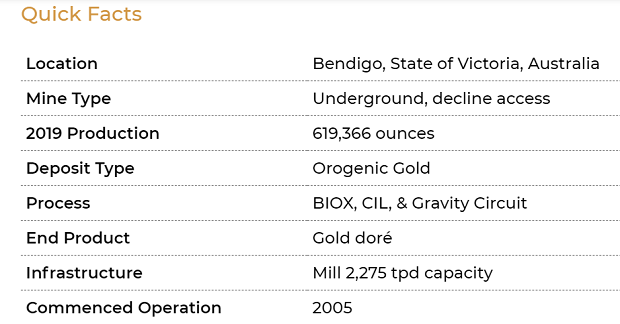
Exploration
The Fosterville property includes approximately 1400 km2 of additional land package with numerous brownfield and greenfield exploration targets which are forming a key aspect of the Company's ongoing exploration efforts. Exploration programs to date have traced only 20km of potential gold bearing structures, highlighting the exceptional exploration potential of this premier gold district. Drilling continues to intersect high-grade gold results in multiple zones and reaffirm increasing grade profiles with depth.
Exploration activities at Fosterville in 2019 are focusing on work to extend known mineralized zones at the Swan Zone, Lower Phoenix, Harrier, and Robbin’s Hill, and also to test for new mineralized structures within the Company’s mining license. In addition, work is continuing on the LODE (“Large Ore Deposit Exploration”) program at Fosterville, which includes greenfield exploration work on several targets within Fosterville’s existing exploration licenses. Exploration expenditures (including capitalized exploration) at Fosterville for the first nine months of 2019 totaled $26.4 million.
2005 COMMENCED OPERATIONS
4XON TRACK TO QUADRUPLE PRODUCTION IN 4 YEARS
(151 KOZS IN 2016, 570 – 610 KOZS IN 2019)
31.0 g/t (RESERVE GRADE) AMONG THE WORLD’S HIGHEST-GRADE GOLD MINES
2016 SWAN ZONE DISCOVERED
Mining method and processing
Mining activities at Fosterville are currently focused on the Central, Phoenix and Harrier underground ore zones. All areas are extracted using open stoping techniques with the application of Cemented Rock Fill where applicable and practical. Selection of the specific mining method within the open stoping regime is based upon previous experience at the Fosterville mine and expectations of ore zone geometry and geotechnical conditions.
Underground mining is conducted using a conventional fleet including jumbos, production drills, loaders, trucks and ancillary equipment. Open Cut mining (when required) is conducted using a conventional fleet including excavators and trucks with the mining fleet and workforce being contract.
The processing path for the ore involves crushing and grinding followed by flotation, bacterial oxidation and CIL circuits. The modern sulphide treatment plant is one of the world’s leading BIOX systems and has achieved record recoveries. In addition, the Company installed a gravity gold circuit in 2016. Fosterville commenced production in April of 2005 and produced its one millionth ounce of gold in December 2015, representing an important milestone of safe and sustainable production at the mine. In 2018, the operation produced 356,230 ounces of gold at an average grade of 24.9 g/t Au, with the Fosterville Mill achieving a record average recovery rate of 97.3%.
Geology & Mineralization
The Fosterville Goldfield is located within the Bendigo Structural Zone in the Lachlan Fold Belt. The deposit is hosted by an interbedded turbidite sequence of sandstones, siltstones and shales. This sequence has been metamorphosed to sub-greenschist facies and folded into a set of upright, open to closed folds.
Mineralization at Fosterville is controlled by late brittle faulting. These late brittle faults are generally steeply west dipping reverse faults with a series of moderately west dipping reverse splay faults formed in the footwall of the main fault. There are also moderately east dipping faults which have become more significant footwall to the anticlinal offsets along the west dipping faults. Primary gold mineralization occurs as disseminated arsenopyrite and pyrite forming as a selvage to veins in a quartz–carbonate veinlet stockwork. The mineralization is structurally controlled with high-grade zones localized by the geometric relationship between bedding and faulting. Mineralized shoots are typically 4m to 15m thick, 50m to 150m up/down dip and 300m to 1,500m+ down plunge, and have average grades of 5 10 g/t Au, with individual assays up to 60 g/t Au.
Primary gold also occurs as visible gold at Fosterville, where it variably overprints sulphide mineralization, and is found as disseminated fine specks (>1 mm) of gold within host quartz veins. The visible gold is spatially associated with antimony mineralization, in the form of stibnite that occurs with quartz and varies from replacement and infill of earlier quartz-carbonate stockwork veins, to massive stibnite-only veins of up to 0.5m in width. The stibnite-quartz event occurs in favorable structural locations, such as the Phoenix, Eagle and Lower Phoenix structures.
The occurrence of visible gold is becoming increasingly significant at depth and is observed more frequently below an approximate 800m with depth, down-plunge within the Lower Phoenix and Harrier Gold Systems.
Examples of the visible high-grade gold zones include the Eagle and Swan Zones in the Lower Phoenix area. The Eagle Zone is 0.5 6m in width, 50 80m in dip length and has a down-plunge extent of 700m. The Swan Zone, currently the highest grade mineralized zone at Fosterville, is 2-5m in width, dips west and is presently defined over a 275m strike and a 200m vertical extent. The Eagle and Swan Zones remain open down-plunge for potential Mineral Resource expansion.
